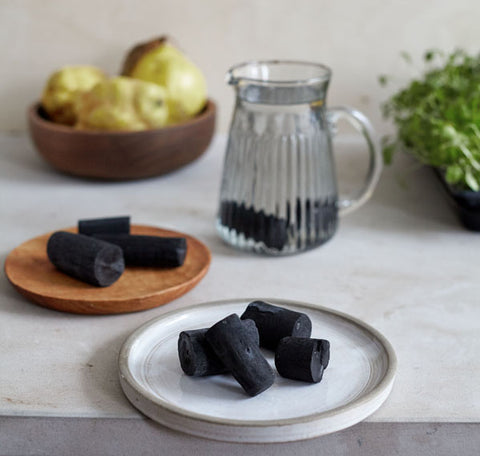Charcoal water filter

Why use Binchotan Charcoal?
It may seem counter intuitive to purify your drinking water with a stick of charcoal, but the Japanese have been doing it for centuries. Our Binchotan uses a traditional Japanese manufacturing method. It is an active carbon made from sustainably coppiced tree branches and is renowned for its ability to soften water, add good minerals and absorb unwanted tastes and odours, such as chlorine.

How do I use it?
Boil the charcoal in water for 10minutes before use. Then fill your bottle/carafe with drinking (potable) tap water and wait for the charcoal to filter impurities from the water. Leaving it overnight is ideal, but you will taste the difference after just one hour. Then, enjoy great tasting water! You can use the charcoal in our Eau Carafe, Personal Carafe, or any bottle, jug or dispenser.
How much charcoal do I need to use?
Use approximately 50g of charcoal per 1litre of water.
Do I need to wash/clean the charcoal?
Boil the charcoal in water for 10minutes before use.
How long does it last?
With time, you will notice a decrease in the filter’s effectiveness on the water taste. You can then recharge it by simply boiling it for ten minutes. The boiling washes out the impurities and frees the charcoal up to absorb some more. Some people have more sensitive taste buds than others so if you notice the decline in taste before 3 months has passed, then it is absolutely fine to boil it at that stage too. Giving it a total life span of six months, as long as it delivers the desired effect, it means it is working!
How does it work?
Binchotan charcoal has an incredibly porous surface with tiny cavities oriented in many directions. Just 1 gram has a surface area in excess of 500 m2 (about one tenth the size of a football field). It is also known as active carbon as the ions of contaminants are attracted to the surface of the carbon, where they will be held. It is also able to release minerals such as calcium, iron and magnesium back into the water which enhances its taste and health benefits.
Is it dangerous if I swallow a bit of charcoal?
Occasionally you will notice tiny particles / fragments of the charcoal in the water, but do not be alarmed as it will do you no harm if you swallow them (active charcoal tablets are prescribed to treat diarrhoea, digestion and flatulence).

What other uses does the binchotan have?
When you have finished using your binchotan as a water filter, it still has many secondary uses. If you break it up and put it in your house plants, it will add nutrients to the soil that will help the plant to grow. Because of its porous surface, it can be used as a deodoriser to remove unwanted odors in your cat litter, laundry basket, nappy bin or shoes. Binchotan is also an effective moisture absorbent, and can help absorb humidity in the air if placed in a wardrobe. It can also help extend the life of fresh produce if placed in your fridge vegetable drawer or fruit bowl, by absorbing ethylene.
Can I use my binchotan with flavoured water (fruit/herb infused or tea)?
Please do not use with flavoured cordials, fruit infusions or tea.
What is the history of Binchotan charcoal?
The origins are not completely clear, but it is believed that a form of Binchotan charcoal (sometimes referred to as 'white charcoal') was introduced to Japan by a Japanese monk and scholar called Kukai 1,200 years ago. It was during the Edo Period (17th century) that a man called Binchuya Chozaemon made it popular.
How is it made?
Sustainably sourced wood is placed in a kiln and charred at a relatively low temperature for some time, then, near the end of the process, the kiln temperature is raised to about 1000 degree Celsius to make the wood red-hot. The charcoal is then removed and quickly covered with a special powder made from earth, sand and ash, and this gives the charcoal surface a whitish hue (explaining the name 'white charcoal'). The rapid rise in temperature, followed by a rapid cooling, incinerates the bark and leaves a smooth, hard surface. If you strike it, you'll hear a clear, metallic sound.
Where is it made?
With sustainability at the forefront of everything we do, we decided to source our charcoal from the skilled artisan charcoal makers of Laos because they follow strict conservation rules to protect the surrounding forests they collect wood from. They only prune the branches of their fast growing native trees and do not remove the roots. This means the trees can grow back, and be harvested again, in five year rotations.



